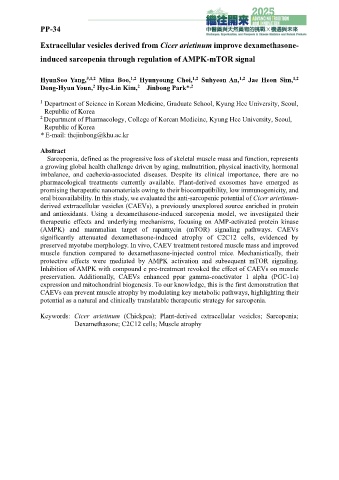Page 216 - 2025中醫藥與天然藥物聯合學術研討會-中醫藥與天然藥物的挑戰X機遇與未來大會手冊
P. 216
PP-34
Extracellular vesicles derived from Cicer arietinum improve dexamethasone-
induced sarcopenia through regulation of AMPK-mTOR signal
1,2
1,2
1,2
1,2
HyunSoo Yang, #,1,2 Mina Boo, Hyunyoung Choi, Suhyeon An, Jae Heon Sim,
Dong-Hyun Youn, Hye-Lin Kim, Jinbong Park*
2
,2
2
1 Department of Science in Korean Medicine, Graduate School, Kyung Hee University, Seoul,
Republic of Korea
2 Department of Pharmacology, College of Korean Medicine, Kyung Hee University, Seoul,
Republic of Korea
* E-mail: thejinbong@khu.ac.kr
Abstract
Sarcopenia, defined as the progressive loss of skeletal muscle mass and function, represents
a growing global health challenge driven by aging, malnutrition, physical inactivity, hormonal
imbalance, and cachexia-associated diseases. Despite its clinical importance, there are no
pharmacological treatments currently available. Plant-derived exosomes have emerged as
promising therapeutic nanomaterials owing to their biocompatibility, low immunogenicity, and
oral bioavailability. In this study, we evaluated the anti-sarcopenic potential of Cicer arietinum-
derived extrracellular vesicles (CAEVs), a previously unexplored source enriched in protein
and antioxidants. Using a dexamethasone-induced sarcopenia model, we investigated their
therapeutic effects and underlying mechanisms, focusing on AMP-activated protein kinase
(AMPK) and mammalian target of rapamycin (mTOR) signaling pathways. CAEVs
significantly attenuated dexamethasone-induced atrophy of C2C12 cells, evidenced by
preserved myotube morphology. In vivo, CAEV treatment restored muscle mass and improved
muscle function compared to dexamethasone-injected control mice. Mechanistically, their
protective effects were mediated by AMPK activation and subsequent mTOR signaling.
Inhibition of AMPK with compound c pre-treatment revoked the effect of CAEVs on muscle
preservation. Additionally, CAEVs enhanced ppar gamma-coactivator 1 alpha (PGC-1α)
expression and mitochondrial biogenesis. To our knowledge, this is the first demonstration that
CAEVs can prevent muscle atrophy by modulating key metabolic pathways, highlighting their
potential as a natural and clinically translatable therapeutic strategy for sarcopenia.
Keywords: Cicer arietinum (Chickpea); Plant-derived extracellular vesicles; Sarcopenia;
Dexamethasone; C2C12 cells; Muscle atrophy

